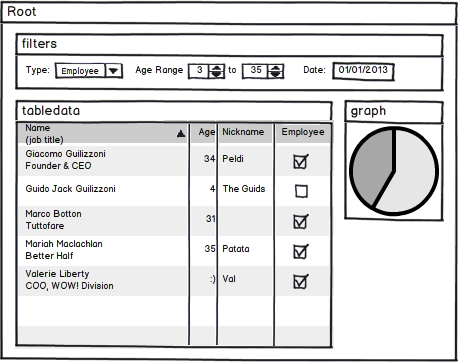【转载】angularJs模块ui-router之多视图
原文地址:http://bubkoo.com/2014/01/01/angular/ui-router/guide/multiple-named-views/
可以给ui-view指定名称,这样一个模板中就可以有多个ui-view。假设您有一个应用,需要动态填充graph、table data和filters,像下面这样:

当您需要使用多视图时,需要用到状态的views属性,views属性值是一个对象。
设置views属性将覆盖覆盖的template属性
如果在状态中定义了views属性,那么状态中的templateUrl、template 和 templateProvider属性将被忽略。
示例 - 名称匹配
views的属性key应该对应的ui-view的名称、像下面这样:
<!-- index.html --> <body> <div ui-view="filters"></div> <div ui-view="tabledata"></div> <div ui-view="graph"></div> </body>
$stateProvider .state('report', { views: { 'filters': { ... templates and/or controllers ... }, 'tabledata': {}, 'graph': {}, } })
然后views中的每一个 view 都可以设置自身的模板属性(template,templateUrl,templateProvider) 和控制器属性(controller,controllerProvider)。
$stateProvider .state('report',{ views: { 'filters': { templateUrl: 'report-filters.html', controller: function($scope){ ... controller stuff just for filters view ... } }, 'tabledata': { templateUrl: 'report-table.html', controller: function($scope){ ... controller stuff just for tabledata view ... } }, 'graph': { templateUrl: 'report-graph.html', controller: function($scope){ ... controller stuff just for graph view ... } }, } })
视图名称 - 相对命名与绝对命名
在定义views属性时,如果视图名称中包含@,那么视图名称就是绝对命名的方式,否则就是相对命名的方式。相对命名的意思是相对于父模板中的ui-view,而绝对命名则指定了相对于哪个状态的模板。
在 ui-router 内部,views属性中的每个视图都被按照viewname@statename的方式分配为绝对名称,viewname是目标模板中的ui-view对应的名称,statename是状态的名称,状态名称对应于一个目标模板。@前面部分为空表示未命名的ui-view,@后面为空则表示相对于根模板,通常是 index.html。
例如,上面的例子可以写成如下方式:
.state('report',{
views: {
'filters@': { },
'tabledata@': { },
'graph@': { }
}
})
注意,这样的写法,视图的名称指定为绝对的名字,而不是相对的名字。这样 ‘filters’,’tabledata’和’graph’三个视图将加载到根视图的模板中(由于没有父状态,则根模板就是index.html)。
绝对命名的方式可以让我们完成一些强大的功能,让我们假设我们有几个模板设置(这里仅仅作为实例演示,有些不现实的地方),像下面这样:
<!-- index.html (root unnamed template) --> <body ng-app> <div ui-view></div> <!-- contacts.html plugs in here --> <div ui-view="status"></div> </body>
<!-- contacts.html --> <h1>My Contacts</h1> <div ui-view></div> <div ui-view="detail"></div>
<!-- contacts.detail.html --> <h1>Contacts Details</h1> <div ui-view="info"></div>
让我们来看看在contacts.detail状态中,相对命名和绝对命名的各种使用方式,请注意,一旦使用了@则表示绝对命名的方式。
$stateProvider .state('contacts', { // 根状态,对应的父模板则是index.html // 所以 contacts.html 将被加载到 index.html 中未命名的 ui-view 中 templateUrl: 'contacts.html' }) .state('contacts.detail', { views: { // 嵌套状态,对应的父模板是 contacts.html // 相对命名 // contacts.html 中 <div ui-view='detail'/> 将对应下面 "detail" : { }, // 相对命名 // 对应 contacts.html 中的未命名 ui-view <div ui-view/> "" : { }, // 绝对命名 // 对应 contacts.detail.html 中 <div ui-view='info'/> "info@contacts.detail" : { } // 绝对命名 // 对应 contacts.html 中 <div ui-view='detail'/> "detail@contacts" : { } // 绝对命名 // 对应 contacts.html 中的未命名 ui-view <div ui-view/> "@contacts" : { } // 绝对命名 // 对应 index.html 中 <div ui-view='status'/> "status@" : { } // 绝对命名 // 对应 index.html 中 <div ui-view/> "@" : { } });
你将发现,不仅仅可以在同一状态设置多个视图,而且祖先状态可以由开发者自由控制:)。



 浙公网安备 33010602011771号
浙公网安备 33010602011771号